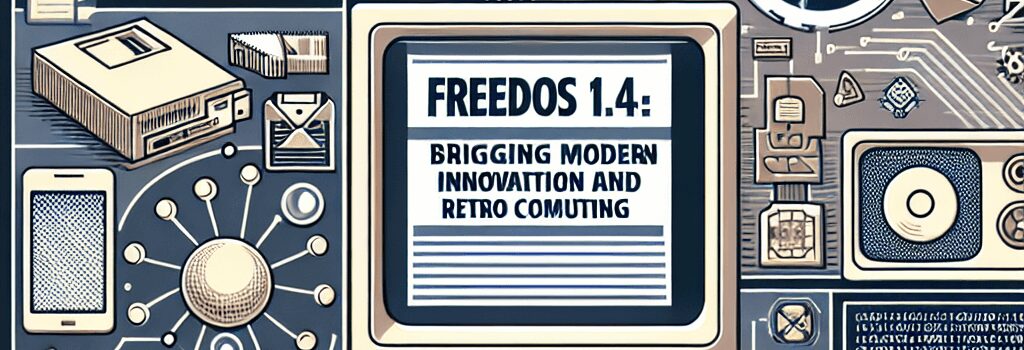FreeDOS 1.4: Bridging Modern Innovation and Retro Computing

Independent developers continue to keep the DOS command prompt spirit alive with the release of FreeDOS 1.4. This update builds on the stable foundation laid by previous versions and brings a host of bug fixes, technical improvements, and new features designed to work seamlessly on both modern PCs and vintage hardware.
Overview of the Release
The FreeDOS team released version 1.4 over the weekend—marking the first stable update since 2022. With a renewed focus on stability, the release includes updates to essential utilities such as the installer, fdisk, format, and the legacy text editor edlin. In addition, updated HTML Help files ensure that users have access to current, easy-to-navigate documentation.
FreeDOS creator and maintainer Jim Hall has provided detailed insights into the changes, with comprehensive release notes available for those interested in a deep dive. The development process featured the release candidate stage as early as January, allowing for extensive testing and refinement.
Installation Formats and Technical Specifications
One of the standout features of FreeDOS 1.4 is the range of installation options available. The standard install image is designed for a full-featured FreeDOS environment, including development tools and the OpenGEM graphical interface, available as a separate BonusCD download.
- Modern PCs: ISO and USB installers are optimized for hardware produced since the turn of the millennium, making the creation of bootable CDs, DVDs, or USB drives a straightforward process.
- Vintage Systems: For older hardware, the Floppy-Only Edition has been tailored to fit on 720KB, 1.44MB, or even 1.2MB floppy disks. This version sometimes omits elements such as FreeDOS source code to conserve precious storage space, yet still provides a limited yet functional set of utilities tailored for classic DOS environments.
The technical breadth of this release not only facilitates support for a wide array of hardware but also demonstrates the team’s commitment to keeping legacy platforms viable alongside contemporary computer architectures.
Technical Enhancements and Performance Improvements
This update emphasizes performance optimizations and improved system utilities. The updated installer now benefits from enhanced compatibility routines, ensuring smoother installation on diverse systems. Specific tool improvements include:
- fdisk: Enhanced partition management capabilities with better handling of edge cases, ensuring data integrity on both legacy and modern storage media.
- format: Increased reliability and speed when formatting drives, with support for larger disk images in virtualized environments.
- edlin: Despite its age, edlin remains a critical tool for DOS-based systems; its improved stability makes it a more reliable option for emergency system recovery.
Additional updates include meticulously refined HTML Help files. This modernization of the help system underscores the project’s commitment to providing end-users with accessible and detailed documentation—a significant factor in lowering the learning curve for new users and developers alike.
Expert Analysis and Community Insights
Industry experts consider the FreeDOS project a crucial link between past and present computing practices. Jim Hall’s efforts are frequently highlighted in technical interviews and discussions, such as his detailed conversation with Ars Technica in 2024. His work ensures that a community of enthusiasts and professionals continues to explore and extend the DOS command line’s capabilities.
Commentators note that FreeDOS 1.4 is not just a nostalgia-driven update but a robust, technically sound environment. With continuous improvements, the platform is well-suited to serve both retro computing hobbies and niche applications in constrained embedded systems, where lightweight OS solutions are prized.
Deeper Analysis: Impact on Legacy and Virtualized Systems
The dual nature of FreeDOS 1.4 exemplifies its versatility. For retro computing aficionados, the Floppy-Only Edition demonstrates an almost artful balance between minimalism and utility. On the other hand, modern installations via ISO or USB images are optimized for use in virtualized environments, ensuring that even within contemporary hardware infrastructures, legacy applications can run effectively.
Technical analysts have highlighted that the update incorporates newly patched drivers and compatibility fixes that reflect ongoing community engagement. In many cases, FreeDOS serves as a platform to test and validate boot protocols on both real and emulated machines. As virtualization technology continues to evolve, having a lightweight and efficient operating system like FreeDOS can be a valuable testing ground for developers.
Future Direction and Development Community
Looking ahead, FreeDOS remains committed to addressing user feedback and expanding its compatibility with emerging hardware standards. The ongoing involvement of the Open Source community brings fresh perspectives and technical contributions to the table. With potential integrations such as support for more advanced graphical interfaces and extended networking capabilities, FreeDOS might well become an inspiring case study on how to maintain legacy software in a rapidly evolving tech landscape.
Overall, FreeDOS 1.4 is not only a testament to the enduring spirit of DOS but also a technically robust offering that bridges decades of computing history.